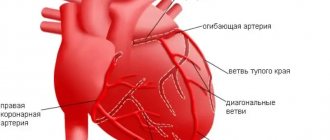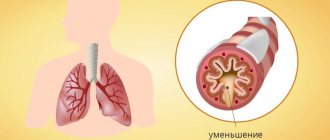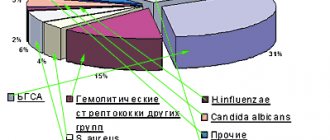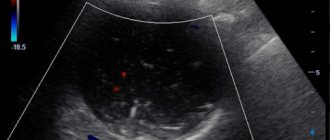Chronic bronchitis is a chronic lesion of the bronchi, manifested by a cough with sputum production for 3 months a year for 2 years in a row.
Most often, chronic bronchitis develops in smokers, against the background of prolonged exposure to dust and other irritants (construction workers, workers in weaving and spinning factories, etc.). The main cause of chronic bronchitis is a viral or bacterial infection that persists for a long time in the altered bronchi.
Types of bronchitis
Depending on the duration of the disease, acute and chronic forms are distinguished. A type of chronic is obstructive bronchitis. It develops when the mucous membrane swells so much that it causes almost complete blockage of the bronchi. With obstructive bronchitis, intoxication (accumulation of toxins in the body) is more pronounced, the temperature rises to 37-38 ° C, weakness, headache, cough accompanied by wheezing or whistling appear. Acute bronchitis usually goes away in a couple of weeks, while chronic bronchitis can last for years. The disease is considered chronic if its symptoms (primarily a wet cough) persist for at least three months a year for two or more years. Bronchitis may recede for a while and hardly notice itself, and then return. Exacerbations (they can be rare, frequent and constantly recurring) alternate with periods of remission or subsidence of symptoms, when the patient is only bothered by a mild cough that does not greatly affect the quality of life. It is quite difficult to completely cure chronic bronchitis in adults. The goal of treatment is to prolong the remission phase as much as possible, reducing the frequency of exacerbations, and slow down the progression of the disease.
How to recognize chronic bronchitis
During the period of remission, the patient feels normal or almost normal: a morning cough with scanty sputum becomes a common occurrence for him. However, with the onset of an exacerbation, which can be repeated several times a year, the person’s condition noticeably worsens. The main sign of exacerbation is a severe cough, accompanied by copious sputum, often purulent (during remission it is mucous, transparent and odorless).
Other symptoms of chronic bronchitis are not always observed - their presence and severity depend on the degree of damage to the bronchi. Most often there are:
- shortness of breath, which first manifests itself during physical exertion and then at rest;
- bronchospasm - an attack of suffocation combined with a painful cough;
- heavy sweating;
- increase in temperature (usually slight);
- general malaise, fatigue.
If bronchitis is not treated
With each new exacerbation of chronic bronchitis in adults, the symptoms tend to intensify. For example, a cough, which in the early stages of a chronic disease only bothers you in the morning, eventually becomes almost around the clock. In the case of bronchial obstruction, wheezing appears, breathing becomes wheezing, asthmatic syndrome develops, and cyanosis (blue discoloration of the skin) is possible. It occurs due to poor oxygen saturation of the blood and high hemoglobin content. Cyanosis itself does not cause pain, but requires immediate medical attention. If bronchitis is advanced, hemoptysis is possible - the appearance of streaks of blood in the sputum. Here there is a danger of the disease passing into a hemorrhagic form, in which the bronchial mucosa is severely damaged, blood clotting is reduced, and there is a danger of suppuration developing.
What are the causes of bronchitis?
All causes of the disease can be divided into three large categories:
Infectious lesions.
The causative agents may be:
- viruses (adenovirus, influenza virus);
- bacteria (usually strepto-, pneumo- and staphylococci);
- atypical microorganisms such as mycoplasma or chlamydia;
- fungal infections.
Exposure to chemical factors.
These include:
- toxic compounds found in the atmosphere of industrial cities;
- increased content of smoke and/or dust in the air;
- occupational hazards in the form of fumes hazardous to health;
- smoking abuse.
Internal factors.
This is, first of all, individual intolerance to certain substances, manifested by an allergic reaction (inflammation) on the bronchial mucosa. Diseases of the cardiovascular and pulmonary systems, as well as chronic infectious and inflammatory disorders in the nasopharynx, oral cavity and tonsils can also provoke the occurrence of pathology.
How to diagnose the disease
Before treating chronic bronchitis, it is necessary to establish a correct diagnosis. For this purpose, the doctor (usually a pulmonologist) taps and listens to the chest. To exclude more serious diseases, the patient must undergo a comprehensive examination (instrumental and laboratory).
Instrumental methods include:
- radiography and fluoroscopy of the lungs,
- bronchoscopy and bronchography,
- determination of blood gas composition.
Laboratory tests include:
- general and biochemical blood test,
- sputum analysis,
- immunological analysis.
Treatment tactics
The main method of therapy is taking medications. Drugs are selected taking into account the causes of the disease. For bacterial infections, antibiotics are indicated, while for viral, fungal and allergic forms they are pointless. Mucolytics are used to thin sputum, and bronchodilators (inhalations) are used to expand the diameter of bronchial branches.
In addition, the pulmonologist takes into account what signs of chronic bronchitis or the acute form bother the patient. Based on these data, symptomatic treatment is prescribed. It is possible to take antitussive and antipyretic drugs. To improve your well-being, it is recommended to drink plenty of fluids, humidify the air in the room, and use a nebulizer.
Why does chronic bronchitis occur?
Inattention to one's health.
Chronic bronchitis can be a consequence of untreated acute bronchitis or frequent respiratory diseases, or result from prolonged exposure to irritating factors on the bronchi.
Working conditions and environmental conditions are of no small importance (smog is especially dangerous). Smoking, allergies and hazardous working conditions.
Inhalation of tobacco smoke is recognized as the main cause of the development of chronic bronchitis, both active and passive.
The disease is diagnosed in smokers 3–4 times more often than in non-smokers. A high percentage of cases of chronic bronchitis occur in people with allergies. Representatives of professions who are forced to come into contact with pesticides, varnishes, paint, dust, chlorine and ammonia vapors, cement, coal and flour dust, as well as those who work at low temperatures and in drafts, often suffer from bronchitis. Attacks on the immune system.
Infectious and viral diseases, especially influenza, also provoke exacerbations of chronic bronchitis. Cold, damp climate and frequent fogs can also play a role - in this case, the risk of relapse increases in autumn, winter and spring. There is also a known hereditary predisposition to bronchitis and congenital pathologies of the bronchi, which increase susceptibility to the effects of adverse environmental factors. A weakened immune system plays a central role in the development of bronchitis: the body's resistance - the ability to resist infections and other adverse factors - decreases.
Definition and risk factors
Bronchitis (obstructive bronchitis) is an inflammatory disease of the respiratory system that affects the bronchi.
Swelling of the bronchi and excessive mucus in the respiratory tract due to the inflammatory process prevent the flow of air to the lungs, which leads to difficulty breathing.
Depending on the etiology there are:
- viral bronchitis
- bacterial bronchitis.
Also, this disease is classified depending on the duration and characteristics of the course into acute bronchitis and chronic bronchitis . The symptoms and treatment of these two forms of bronchitis have some differences.
Factors influencing the development of bronchitis
The main reasons why bronchitis may develop:
- smoking
- unfavorable climatic living conditions
- harmful working conditions
- frequent hypothermia
- inhalation of toxic substances.
Smoker's bronchitis is especially common . Symptoms of bronchitis caused by exposure to tobacco smoke are particularly difficult to treat.
How to treat chronic bronchitis
In case of exacerbation of the chronic process, treatment is aimed at eliminating inflammation, strengthening the immune system, and improving bronchial patency. Before treating chronic bronchitis, it is necessary to eliminate provoking factors, if any: stop smoking and, if possible, protect yourself from dusty air and harmful fumes. Only with this approach can a confident positive effect be achieved. Treatment of chronic bronchitis should be prescribed by a doctor. Antibiotics can be used as indicated. A bacterial analysis is first carried out to determine which antibiotics the pathogen is sensitive to.
In the complex treatment of chronic bronchitis in adults, drugs can be used that:
- relieve inflammation (anti-inflammatory);
- increase immunity (immunostimulating);
- relax and dilate the bronchi (bronchodilators);
- thin sputum (mucolytics);
- facilitate the removal of mucus (expectorants);
- block acetylcholine receptors (anticholinergics);
- weaken obstruction, that is, obstruction of the airways (glucocorticosteroids).
Doctor MOM® cough syrup based on extracts of 10 medicinal plants has a complex effect - mucolytic, expectorant, bronchodilator and anti-inflammatory. The syrup is suitable for adults and children over 3 years old.
Both during exacerbations of chronic bronchitis and in the remission phase, in addition to drug treatment, the following are recommended:
- taking vitamins;
- physiotherapy;
- breathing exercises, including drainage exercises that promote the removal of sputum;
- percussion massage for cough, which has a bronchial relaxant effect;
- physiotherapeutic procedures;
- non-traditional treatment methods (for example, acupuncture).
Any therapy is prescribed by a doctor.
Chronic bronchitis (CB) is a chronic inflammatory disease of the bronchi, caused by prolonged irritation of the airways by volatile pollutants and/or damage by viral-bacterial agents, characterized by a morphological restructuring of their mucous membrane, accompanied by hypersecretion of mucus, a violation of the cleansing function of the bronchi, which is manifested by a constant or periodic cough and sputum production. According to WHO recommendations, bronchitis can be considered chronic if the patient coughs up sputum on most days for at least 3 months in a row for more than 2 years in a row. Chronic bronchitis is divided into primary and secondary. Primary CB is an independent disease, not associated with any other bronchopulmonary processes or damage to other organs and systems. In primary chronic bronchitis, diffuse damage to the bronchial tree is observed. Secondary chronic disease develops against the background of other diseases, both pulmonary (tuberculosis, bronchiectasis, etc.) and extrapulmonary (uremia, congestive heart failure, etc.). Most often, secondary CB is local in nature. This article discusses only primary chronic bronchitis, which makes up about 30% of the structure of nonspecific lung diseases among the urban population. There is currently no generally accepted classification of chronic bronchitis. The following forms of CB are distinguished, taking into account the nature of the inflammatory process: catarrhal, catarrhal-purulent and purulent. The classification also includes rare forms - hemorrhagic and fibrinous chronic bronchitis. According to the nature of the course, CB can be divided into those without obstruction and those with airway obstruction. According to the level of damage to the bronchi - with predominant damage to large (proximal bronchitis) or small bronchi (distal bronchitis) (Paleev N.R. et al., 1985). Exogenous and endogenous factors closely interact in the occurrence and development of CB. Among exogenous factors, a significant role is played by irritating and damaging pollutants (domestic and professional), as well as non-indifferent dusts, which have a harmful (chemical and mechanical) effect on the bronchial mucosa. Inhalation of tobacco smoke should be placed in first place in importance among exogenous factors. Air pollution and unfavorable climatic factors (hypothermia and overheating) are of great importance. A lesser role among the etiological factors is played by viral (influenza viruses, adenoviruses), mycoplasma and bacterial infections (pneumococcus, Haemophilus influenzae, moraxella), but its importance increases sharply with exacerbation of chronic bronchitis. Due to the fact that the disease does not occur in all individuals exposed to the same adverse effects, endogenous factors that determine the development of chronic disease are also identified: pathology of the nasopharynx, changes in breathing through the nose with impaired cleansing, moistening and warming of inhaled air; repeated acute respiratory diseases, acute bronchitis and focal infection of the upper respiratory tract, impaired local immunity and metabolism (obesity). In the pathogenesis of CB, the main role is played by disruption of the secretory, cleansing and protective functions of the bronchial mucosa, leading to changes in mucociliary transport. Under the influence of exogenous and endogenous factors, a number of pathological processes occur in the tracheobronchial tree (figure).
The main pathogenetic mechanisms of the development and progression of CB The structural and functional properties of the mucous membrane and submucosal layer change, which is expressed in hyperplasia and hyperfunction of goblet cells, bronchial glands, hypersecretion of mucus and changes in its properties (the mucous secretion becomes thick, viscous and sucks in the cilia of the ciliated epithelium). All this leads to disruption in the mucociliary transport system. The effectiveness of mucociliary transport of the bronchi depends on two main factors: the mucociliary escalator, determined by the function of the ciliated epithelium of the mucosa, and the rheological properties of the bronchial secretion (its viscosity and elasticity), and is determined by the optimal ratio of its two layers - the outer (gel) and the internal (sol). Inflammation of the mucous membrane is caused by various irritants in combination with infection (viral and bacterial). The production of secretory IgA decreases, the content of lysozyme and lactoferrin in the mucus decreases. Edema of the mucous membrane develops, followed by atrophy and metaplasia of the epithelium. Chemicals in the air cause damage to the respiratory tract, accompanied by swelling of the mucous membrane and bronchospasm. This leads to disruption of the evacuation and decrease in the barrier functions of the bronchial mucosa. Catarrhal contents are replaced by catarrhal-purulent, and then purulent. The spread of the inflammatory process to the distal parts of the bronchial tree disrupts the production of surfactant and reduces the activity of alveolar macrophages, which carry out phagocytosis of bacteria and other foreign particles. Violation of the drainage function of the bronchi develops as a result of a combination of a number of factors:
• spasm of bronchial smooth muscles, resulting from the direct irritant effect of exogenous factors and inflammatory changes in the mucous membrane; • hypersecretion of mucus, changes in its rheological properties, leading to disruption of mucociliary transport and blockage of the bronchi with viscous secretions; • epithelial metaplasia from columnar to stratified squamous and its hyperplasia; • disturbances in the production of surfactant; • inflammatory edema and infiltration of the mucous membrane; • allergic changes in the mucous membrane.
Various ratios of changes in the mucous membrane, manifested in its inflammation, determine the formation of one or another clinical form of the disease. With catarrhal bronchitis, superficial changes in the structural and functional properties of the mucous membrane predominate; with mucopurulent (or purulent) bronchitis, infectious inflammation processes predominate. It is possible to transition from one clinical form of bronchitis to another. Thus, catarrhal bronchitis, which lasts for a long time, can, due to the addition of an infection, become mucopurulent, etc. When predominantly large-caliber bronchi are involved in the process (proximal bronchitis), disturbances in bronchial patency are not pronounced. Damage to small bronchi and medium-caliber bronchi often occurs with impaired bronchial obstruction, which, as a rule, is expressed during exacerbation of CB. Ventilation disturbances in chronic bronchitis are usually mild. At the same time, in some patients, disturbances in the drainage function of the bronchi are so pronounced that, based on the nature of the course of CB, it can be interpreted as obstructive. Obstructive disorders in chronic bronchitis, as a rule, appear only against the background of exacerbation of the disease and can be caused by inflammatory changes in the bronchi, hyper- and discrinia, bronchospasm (reversible components of obstruction). In severe CB and persistent inflammation, obstructive changes may persist permanently. Developed obstruction of the small bronchi leads to pulmonary emphysema. There is no direct relationship between the severity of bronchial obstruction and emphysema, since, unlike chronic obstructive pulmonary disease (COPD), emphysema is not a symptom of chronic disease, but a complication of it. In the future, emphysema can lead to the development of respiratory failure with the appearance of shortness of breath, then to the formation of pulmonary hypertension.
Clinical picture of chronic bronchitis The main manifestations of chronic bronchitis are cough and sputum production. In addition, they identify general symptoms (sweating, weakness, increased body temperature, fatigue, decreased ability to work, etc.), which may appear during an exacerbation of the disease or be the result of prolonged chronic intoxication (purulent bronchitis), or arise as manifestations hypoxia with the development of respiratory failure and other complications. At the beginning of the disease, the cough may be unproductive, often dry, and sputum is usually discharged in the morning (when washing). In the phase of stable clinical remission, these patients do not show any complaints; their ability to work can be fully preserved for many years. Patients do not consider themselves sick. Exacerbations of the disease are infrequent, in most patients no more than 2 times a year. The typical seasonality of exacerbations is in early spring or late autumn, when changes in weather factors are most pronounced. Cough is the most typical manifestation of the disease. Based on the nature of the cough and sputum, one or another version of the course of the disease can be assumed. With catarrhal bronchitis, the cough is accompanied by the release of a small amount of mucous sputum, often in the morning, after exercise. At the beginning of the disease, the cough does not bother the patient. If in the future it becomes paroxysmal, this indicates a violation of bronchial obstruction. The cough takes on a barking tone and is paroxysmal in nature with pronounced expiratory collapse of the trachea and large bronchi. The amount of sputum may increase with exacerbation of bronchitis. With purulent and mucopurulent bronchitis, patients are more worried not about coughing, but about sputum production, since sometimes they do not notice that it is released when coughing. In the acute phase, the patient’s well-being is determined by the relationship between two main syndromes: cough and intoxication. Intoxication syndrome is characterized by general symptoms. Changes in the upper respiratory tract are noted: rhinitis, sore throat when swallowing, etc. At the same time, chronic diseases of the nasopharynx (inflammation of the paranasal sinuses, tonsillitis), which often exist in a patient with chronic bronchitis, also worsen. In case of exacerbation of the disease, the sputum becomes purulent in nature, its quantity may increase, and shortness of breath appears due to the addition of obstructive disorders. In this situation, the cough becomes unproductive and annoying, sputum is released in small quantities. In some patients, usually in the acute phase, moderate bronchospasm occurs, the clinical sign of which is difficulty breathing that occurs during physical exertion, going into a cold room, during a strong cough, sometimes at night. In typical cases, CB progresses slowly, shortness of breath usually appears 20-30 years after the onset of the disease, which indicates the development of complications (pulmonary emphysema, respiratory failure). Such patients almost never record the onset of the disease (morning cough with sputum is associated with smoking and is not considered a manifestation of the disease). They consider the beginning of the disease to be the period when complications or frequent exacerbations appear. A history may reveal increased sensitivity to cooling and, in the vast majority of patients, an indication of long-term smoking. In a number of patients, the disease is associated with occupational hazards at work. Men get sick 6 times more often than women. When analyzing a cough history, it is necessary to make sure that the patient does not have another pathology of the bronchopulmonary apparatus (tuberculosis, tumor, bronchiectasis, pneumoconiosis, systemic connective tissue diseases, etc.), accompanied by the same symptoms. This is an indispensable condition for classifying these complaints as manifestations of chronic bronchitis. Some patients have a history of hemoptysis, which is usually associated with slight vulnerability of the bronchial mucosa. Recurrent hemoptysis indicates a hemorrhagic form of bronchitis. In addition, hemoptysis in chronic, long-term bronchitis may be the first symptom of lung cancer that develops in men who have smoked heavily for a long time. Bronchiectasis can also manifest as hemoptysis. In the initial stage of the disease, physical pathological symptoms may be absent. Subsequently, changes appear on auscultation: harsh breathing (with the development of emphysema it can become weakened) and dry wheezing of a scattered nature, the timbre of which depends on the caliber of the affected bronchi. As a rule, rough buzzing dry rales are heard, which indicates the involvement of large and medium bronchi in the process. Wheezing, especially well audible on exhalation, is characteristic of damage to the small bronchi, which is evidence of the addition of bronchospastic syndrome. If wheezing is not heard during normal breathing, then auscultation should be performed with forced breathing, as well as with the patient lying down. Changes in auscultation data will be minimal with chronic disease in the remission phase and are most pronounced during an exacerbation of the process, when even unstable moist rales can be heard. Often, during an exacerbation of chronic bronchitis, an obstructive component may appear, accompanied by the appearance of shortness of breath. When examining the patient, signs of bronchial obstruction are revealed:
• prolongation of the expiratory phase during quiet and especially during forced breathing; • wheezing, which is clearly audible during forced exhalation and in a lying position.
The evolution of bronchitis, as well as additional complications, change the data obtained from direct examination of the patient. In advanced cases, there are signs of pulmonary emphysema and respiratory failure. The development of cor pulmonale in non-obstructive chronic bronchitis is extremely rare. In the initial period of the disease or in the remission phase, there may be no changes in laboratory and instrumental parameters. However, at certain stages of the course of chronic disease, data from laboratory and instrumental research methods become significant. They are used to identify the activity of the inflammatory process, clarify the clinical form of the disease, identify complications, and differential diagnosis with diseases that have similar clinical symptoms. An X-ray examination of the chest organs is performed for all patients with chronic bronchitis. In most of them, there are no changes in the lungs on plain radiographs. In some cases, a mesh deformation of the pulmonary pattern is observed, caused by the development of pneumosclerosis. With a long course of the process, signs of pulmonary emphysema are revealed. X-ray examination of the chest organs helps in diagnosing complications (pneumonia, bronchiectasis) and in differential diagnosis with diseases in which symptoms of bronchitis may accompany the main process (tuberculosis, tumor, etc.). Computed tomography of the chest is not used to confirm chronic disease, but to diagnose bronchiectasis. Bronchography has been used somewhat less frequently for the same purpose in recent years. Bronchoscopy is of great importance in the diagnosis of chronic bronchitis and its differentiation from diseases manifested by a similar clinical picture. Bronchoscopic examination has various purposes:
• confirms the presence of an inflammatory process and assesses the degree of its activity; • clarifies the nature of inflammation (the diagnosis of hemorrhagic or fibrinous bronchitis is made only after bronchoscopic examination); • reveals functional disorders of the tracheobronchial tree (bronchoscopic examination plays a leading role in identifying expiratory collapse - dyskinesia of the trachea and large bronchi); • helps in identifying organic lesions of the bronchial tree (strictures, tumors, etc.).
In addition, bronchoscopic examination can be used to obtain bronchial contents or lavage water for microbiological, serological and cytological studies. A study of external respiration function is carried out to identify restrictive and obstructive disorders of pulmonary ventilation. In modern conditions, various parameters of the flow-volume loop obtained by computer spirography are used. In this case, two main indicators are taken into account: the Tiffno index (the ratio of the forced expiratory volume in 1 s - FEV1 - to the vital capacity of the lungs - vital capacity; the same ratio, expressed as a percentage, is the Tiffno coefficient) and the peak expiratory flow rate - PSV (the ratio of maximum ventilation lungs - MVL to vital capacity). In addition, the modified Tiffno coefficient - FEV1/FVC - is calculated for the purpose of differential diagnosis with COPD. COPD is characterized by the FEV1/FVC value. By studying the expiratory flow at a pulmonary volume equal to 75, 50 and 25% FVC, it is possible to clarify the level of bronchial obstruction in the peripheral parts of the bronchial tree: peripheral obstruction is characterized by a significant decrease in the flow-volume curve in the area of small volume, and for proximal obstruction - in an area of large volume. At home, to monitor lung function, it is recommended to determine the peak expiratory flow rate using a pocket device - a peak flow meter. The study of blood gases and acid-base status is important for diagnosing various degrees of respiratory failure. The degree of respiratory failure is assessed taking into account the level of PaO2 and PaCO2. Electrocardiography is necessary to identify hypertrophy of the right ventricle and right atrium that develops in pulmonary hypertension. The most significant signs are the following: pronounced deviation of the QRS axis to the right; shift of the transition zone to the left (R/S Exercise test is recommended in cases where the degree of shortness of breath does not correlate with changes in FEV1. A six-minute walk test is usually used. A clinical blood test during the period of a stable course of the disease is not changed. In chronic bronchitis, secondary bronchitis is sometimes detected erythrocytosis, resulting from chronic hypoxia with severe respiratory failure. The activity of the inflammatory process is reflected by a general blood test to a lesser extent than in other diseases. “Acute-phase” indicators are often moderately expressed: ESR may be normal or moderately increased (due to erythrocytosis, a decrease in ESR is sometimes noted) ; leukocytosis is usually small, as well as a shift of the leukocyte formula to the left. A biochemical blood test is carried out to clarify the activity of the inflammatory process. The content of total protein and its fractions, as well as CRP, sialic acids in the blood serum is determined. However, the decisive role is in assessing the degree of inflammatory activity in the bronchi belongs to the data of the bronchoscopic picture, the study of sputum and bronchial lavage water. Examination of sputum and bronchial contents helps to establish the nature and severity of inflammation. With severe inflammation, the contents are predominantly purulent or purulent-mucosal, there are many neutrophils, single macrophages, and dystrophically altered cells of the ciliated and squamous epithelium are poorly represented. Moderate inflammation is characterized by contents closer to mucopurulent; the number of neutrophils increased slightly. The number of macrophages, mucus and bronchial epithelial cells increases. Microbiological examination of sputum and bronchial contents is necessary to identify the etiology of exacerbation of chronic bronchitis (pneumococcus, Haemophilus influenzae, etc.) and to select antimicrobial chemotherapy tactics. All complications of chronic bronchitis can be divided into two groups:
1) directly caused by infection: a) pneumonia; b) bronchiectasis; 2) caused by the evolution of bronchitis: a) hemoptysis; b) pulmonary emphysema; c) diffuse pneumosclerosis; d) respiratory failure; e) cor pulmonale (rare).
The formulation of a detailed clinical diagnosis of chronic bronchitis is carried out taking into account the following components: 1) the form of chronic bronchitis; 2) phase of the process (exacerbation-remission); 3) complications. An assessment of the nature of the course when formulating a diagnosis of chronic bronchitis is indicated only in the case of pronounced manifestations of bronchial obstruction.
Treatment of chronic bronchitis The goal of treatment is to reduce the rate of progression of diffuse bronchial damage, reduce the frequency of exacerbations, prolong remission, increase tolerance to physical activity, and improve quality of life. The main direction of treatment and prevention of the progression of chronic disease is the elimination of exposure to harmful impurities in the inhaled air (smoking ban, elimination of exposure to passive smoking, rational employment). The treatment of chronic bronchitis itself should be differentiated and depend on the form of the disease and certain complications. Treatment of CB consists of a set of measures that differ slightly in periods of exacerbation and remission of the disease. There are two main directions of treatment during an exacerbation: etiotropic and pathogenetic. Etiotropic treatment is aimed at eliminating the inflammatory process in the bronchi and includes therapy with antibiotics, antiseptics, phytoncides, etc. Antibiotics are prescribed taking into account the sensitivity of pathogens isolated from sputum or bronchial contents during cultural examination. If sensitivity cannot be determined, then empirical therapy should begin with amoxicillin, and if β-lactam antibiotics are intolerant, with macrolides. Preference is given to oral antibacterial agents. Among the dosage forms of amoxicillin in the treatment of infectious exacerbation of chronic bronchitis, preference should be given to dispersible tablets (Flemoxin Solutab®). The Solutab tablet has a double level of integration of the active antibacterial substance – amoxicillin. First, the antibiotic molecules are combined into microspheres, from which a tablet is subsequently formed. Under the influence of liquid (water, gastric juice), the tablet begins to disintegrate into microspheres, each of which consists of an active substance and an acid-resistant filler. The release of the active substance from the microspheres begins when exposed to bicarbonates in the intestines. Thus, amoxicillin is released in the zone of maximum absorption. The Solutab tablet can be swallowed whole or dissolved in water to form a syrup or suspension. The advantages of the tableted antibacterial drug Flemoxin Solutab® include the following:
• the highest bioavailability among solid dosage forms of amoxicillin (93% vs. 70% for amoxicillin capsules); • predictable absorption regardless of the route of administration; • low incidence of adverse reactions from the gastrointestinal tract due to the low “residual” concentration of amoxicillin in the intestine; • variety of dosages (125, 250, 500, 1000 mg); • ease of reception, preparation and storage due to the Solutab form. Treatment of exacerbations of chronic disease with Flemoxin Solutab® is carried out in a dosage of 500 mg 3 times a day, or 1000 mg 2 times a day for 7-10 days.
In cases of infectious exacerbation of chronic disease in patients with frequent exacerbations who have received systemic antibiotics in the previous 3 months, elderly people with chronic concomitant diseases (CHF, diabetes mellitus, etc.), preference is given to protected aminopenicillins, in particular amoxicillin/clavulanate, which prescribed 625 mg 3 times a day or 1 g 2 times a day, or respiratory fluoroquinolones (levofloxacin 0.5 g 1 time a day or moxifloxacin 0.4 g 1 time a day). Currently, amoxicillin/clavulanate is also produced on the Russian market in the dosage form Solutab - Flemoklav Solutab®, which in comparative clinical studies has demonstrated advantages in the safety profile, in particular the frequency of diarrhea syndrome, over traditional amoxicillin/clavulanate tablets. If such treatment is insufficiently effective, they switch to parenteral administration of third-generation cephalosporins without antipseudomonal activity (cefotaxime intramuscularly or intravenously, 2 g 3 times a day) or cefepime intramuscularly and intravenously, 2 g 2 times a day. Pathogenetic treatment is aimed at improving pulmonary ventilation and restoring bronchial patency. Improvement (restoration) of impaired pulmonary ventilation, in addition to eliminating the inflammatory process in the bronchi, is facilitated by oxygen therapy and exercise therapy. The main thing in the treatment of chronic asthma is the restoration of bronchial patency, which is achieved by improving their drainage and eliminating bronchospasm. In the treatment of chronic bronchitis, it is important to use mucolytic and expectorant drugs: ambroxol orally 30 mg 3 times a day, acetylcysteine orally 200 mg 3-4 times a day, carbocysteine 750 mg 3 times a day, bromhexine orally 8-16 mg 3 times a day. Therapy is carried out for 2 weeks. Herbal preparations (thermopsis, ipecac, mucaltin) are used as alternative medicines. To eliminate bronchospasm, bronchodilators are used. Anticholinergic drugs are used (ipratropium bromide; its combination with fenoterol and methylxanthines (aminophylline and its derivatives). The inhalation route of drug administration is the most preferable and safe. Long-acting aminophylline preparations are also effective, which are prescribed orally only 2 times a day. Physiotherapeutic treatment is prescribed: diathermy , electrophoresis of calcium chloride, quartz on the chest area, chest massage and breathing exercises. Outside the period of exacerbation of mild bronchitis, foci of infection are eliminated; hardening of the body begins. Exercise therapy (breathing exercises) is carried out constantly. For moderate and severe bronchitis , along with anti-relapse and sanatorium-resort treatment (Southern coast of Crimea, dry steppe zone), many patients are forced to constantly receive supportive drug treatment. In moderate cases of chronic disease, constant breathing exercises are required. Maintenance therapy is aimed at improving bronchial patency, reducing pulmonary hypertension and the fight against right ventricular failure. The same drugs are prescribed as during an exacerbation, only in smaller doses, in courses. Primary prevention measures include the prohibition of smoking in institutions and enterprises, improvement of the external environment, prohibition of work in a polluted (dusty and gas-filled) atmosphere, constant prevention of acute respiratory infections, treatment of nasopharyngeal pathology, etc. Secondary prevention measures are all actions aimed at preventing the development of exacerbations diseases.
Literature 1. Zhugzhda A.Yu., Staponkene M.A., Pyatkyavichene R.I., Balchus V.Ya. Evolution of the doctrine of chronic bronchitis // Klin. medicine. 1995; 6; 8-10. 2. Paleev N.R., Ilchenko V.A. Chronical bronchitis. In the book: Respiratory diseases, A guide for doctors / Ed. N.R. Paleeva. M.: Medicine, 1990; 3: 110-176. 3. Practical guide to antimicrobial chemotherapy / Ed. L.S. Strachunsky, Yu.B. Belousova, S.N. Kozlova. Smolensk: MAKMAH, 2007; 64-124, 248-258. 4. Rational pharmacotherapy of respiratory diseases: Hand. for medical practitioners / Ed. Edited by A.G. Chuchalina. M.: Littera, 2004; 331-348, 734. 5. Respiratory medicine / Ed. A.G. Chuchalina. M.: GEOTAR-Media, 2007; 1: 800. 6. Sidorenko S.V., Kozlov S.N. Penicillin group. In the book. Practical guide to anti-infective chemotherapy / Ed. Strachunsky L.S. et al. Borges, 2002; 47-55. 7. Sinopalnikov A.I., Kozlov R.S. Community-acquired respiratory tract infections: a guide for clinicians. 2007; 352. 8. Fenelli K.P., Stuhlbarg M.S. Chronic bronchitis // Pulmonology. 2004; 2:6-13. 9. Chambers HF Penicillins/ In: Principles and Practice Infectious Diseases, 6th ed. 2005; 281-93. 10. Global Initiative for Chronic Obstructive Lung Diseas (GOLD). 2006; 1-96. Available on: www.Goldcopd.com.
Why is chronic bronchitis dangerous?
If chronic bronchitis is left without adequate comprehensive treatment, the patient will feel worse and worse. The list of possible complications looks serious. Among them are diseases that are difficult to cure:
- pneumonia (pneumonia);
- asthmatic syndrome, bronchial asthma;
- heart and respiratory failure;
- Pulmonary emphysema is a pathological change in the lung tissue, which is characterized by severe shortness of breath and an increase in the volume of the chest.
That is why it is so important to pay great attention to the treatment of chronic bronchitis, not only during periods of exacerbation, but also during remission.
Treatment of bronchitis in Kaliningrad
If you have a cough or general deterioration in health, you should consult a pulmonologist. The specialist will assess the condition of the bronchi and lungs, prescribe treatment that will quickly improve your well-being and protect against complications.
Five reasons to contact our Pulmonology Center:
- qualified specialists;
- laboratory diagnosis of lung diseases;
- full range of instrumental studies;
- help with any pathologies: treatment of bronchial asthma, treatment of COPD;
- personal approach taking into account wishes and contraindications.
Make an appointment with a pulmonologist by calling 8 (4012) 971-961.









